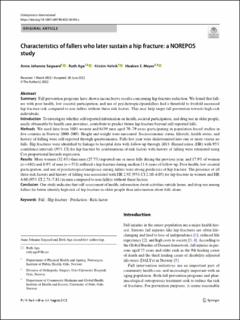| dc.description.abstract | Fall prevention programs have shown inconclusive results concerning hip fracture reduction. We found that fallers with poor health, low societal participation, and use of psychotropics/painkillers had a threefold to fivefold increased hip fracture risk compared to non-fallers without these risk factors. This may help target fall prevention towards high-risk individuals. Introduction: To investigate whether self-reported information on health, societal participation, and drug use in older people, easily obtainable by health care providers, contribute to predict future hip fracture beyond self-reported falls. Methods: We used data from 3801 women and 6439 men aged 70-79 years participating in population-based studies in five counties in Norway 2000-2003. Height and weight were measured. Socioeconomic status, lifestyle, health status, and history of falling were self-reported through questionnaires. Falls last year were dichotomized into one or more versus no falls. Hip fractures were identified by linkage to hospital data with follow-up through 2013. Hazard ratios (HR) with 95% confidence intervals (95% CI) for hip fracture by combinations of risk factors with history of falling were estimated using Cox proportional hazards regression. Results: More women (32.4%) than men (27.7%) reported one or more falls during the previous year, and 17.9% of women (n = 682) and 8.9% of men (n = 572) suffered a hip fracture during median 11.6 years of follow-up. Poor health, low societal participation, and use of psychotropics/analgesics among fallers were strong predictors of hip fracture. The presence of all three risk factors and history of falling was associated with HR 2.92 (95% CI 2.10-4.05) for hip fracture in women and HR 4.60 (95% CI 2.71-7.81) in men compared to non-fallers without these factors. Conclusion: Our study indicates that self-assessment of health, information about activities outside home, and drug use among fallers far better identify high risk of hip fracture in older people than information about falls alone. | |
